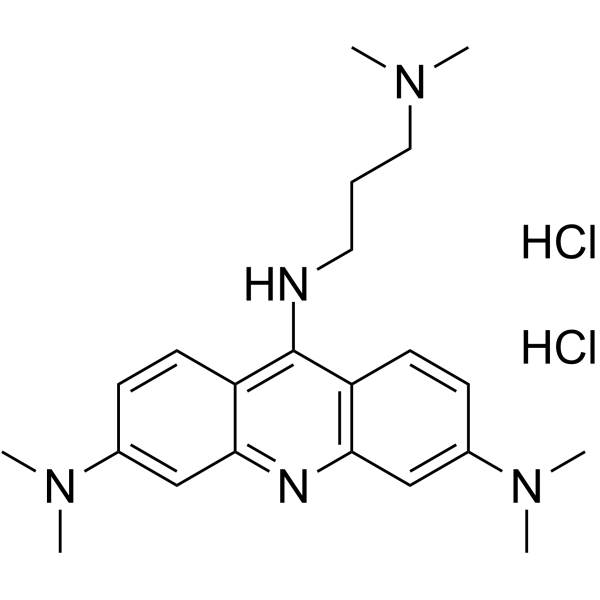| Description |
3,6-DMAD dihydrochloride, an acridine derivative, is a potent IRE1α-XBP1s pathway inhibitor. 3,6-DMAD dihydrochloride promotes IL-6 secretion via the IRE1α-XBP1s pathway. 3,6-DMAD dihydrochloride inhibits IRE1α oligomerization and endoribonuclease (RNase) activity. 3,6-DMAD dihydrochloride can be used for research of cancer[1][2].
|
| Related Catalog |
|
| In Vitro |
3,6-DMAD dihydrochloride (0-6 μM; 24 h; RPMI 8226 and MM1.R human MM cells) has cytotoxicity against MM cell lines[1]. 3,6-DMAD dihydrochloride (0-30 μM; 14 h; HT1080 cells treated with Tg (0.3 μM)) inhibits XBP1 splicing (XBP1s) in a dose dependent manner[1]. 3,6-DMAD dihydrochloride (0.1-500 μM; 14 h; HT1080 cells treated with Tg (0.3 μM)) inhibits IRE1α endonuclease activity[1]. 3,6-DMAD dihydrochloride (1-60 μM; 2 h; HEK293 cells) inhibits IRE1α oligomerization and IRE1α-GFP foci formation[1]. Cell Viability Assay[1] Cell Line: RPMI 8226 and MM1.R human MM cells Concentration: 0, 0.5, 1, 2, 3, 4, 5 and 6 μM Incubation Time: 24 hours Result: Inhibited cell survival rate in a dose dependent manner. Cell Viability Assay[1] Cell Line: 0, 5, 10 and 30 μM Concentration: 0, 0.5, 1, 2, 3, 4, 5 and 6 μM24 hours Incubation Time: 14 hours Result: Showed XBP1s inhibition at as low as 0.5 μM.
|
| In Vivo |
3,6-DMAD dihydrochloride (10 mg/kg; i.p.; three times every 12 hours, for 84 hours; NOD Scid mice with RPMI 8226 xenograft) has inhibition of XBP1 splicing in vivo[1]. 3,6-DMAD dihydrochloride (10 mg/kg; 24 h; i.p.; every 48 hours, for 12 days; NOD Scid mice with RPMI 8226 xenograft) suppresses multiple myeloma xenograft growth in vivo[1]. Animal Model: NOD Scid mice (4-6 weeks) with RPMI 8226 xenograft[1] Dosage: 10 mg/kg Administration: Intraperitoneal injection; three times every 12 hours, for 84 hours Result: Inhibited XBP1-luciferase activity in NOD Scid mice with RPMI 8226 xenograft. Animal Model: NOD Scid mice (4-6 weeks) with RPMI 8226 xenograft[1] Dosage: 10 mg/kg Administration: Intraperitoneal injection; every 48 hours, for 12 days Result: Inhibited tumor growth in NOD Scid mice with RPMI 8226 xenograft.
|
| References |
[1]. Jiang D, et, al. Acridine Derivatives as Inhibitors of the IRE1α-XBP1 Pathway Are Cytotoxic to Human Multiple Myeloma. Mol Cancer Ther. 2016 Sep;15(9):2055-65. [2]. De SY, et, al. SHP-2 specific deletion in macrophages accelerates pathological cardiac hypertrophy through promoting IRE1α-XBP1s pathway regulated by IL-6 secretion. Research Article. 2022 May 3.
|
